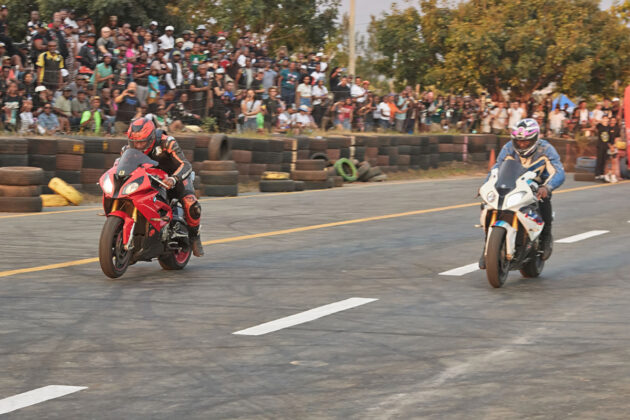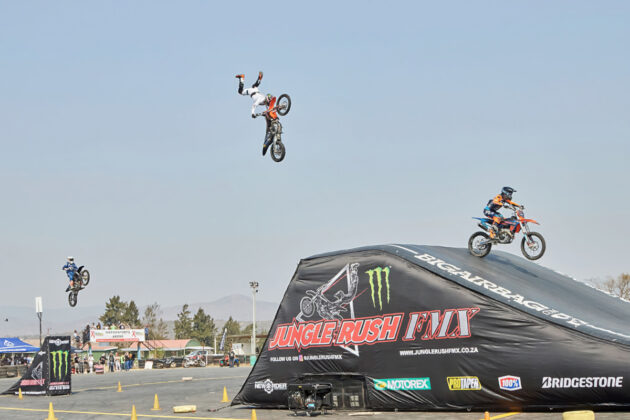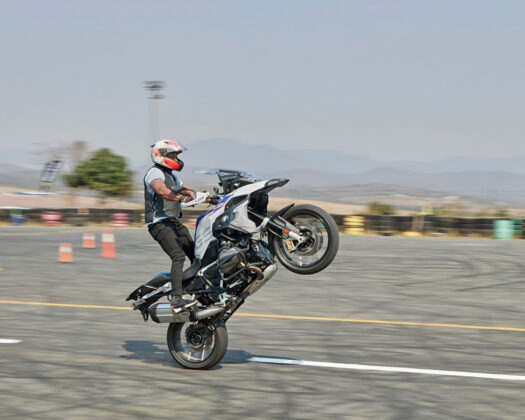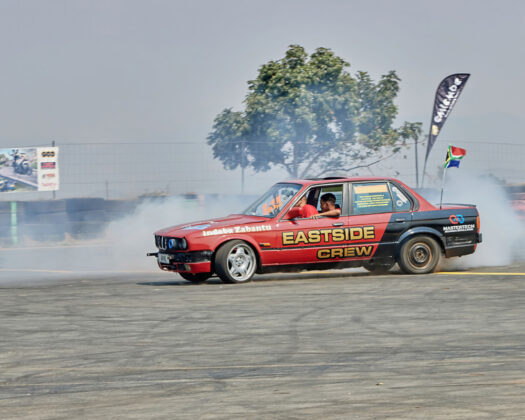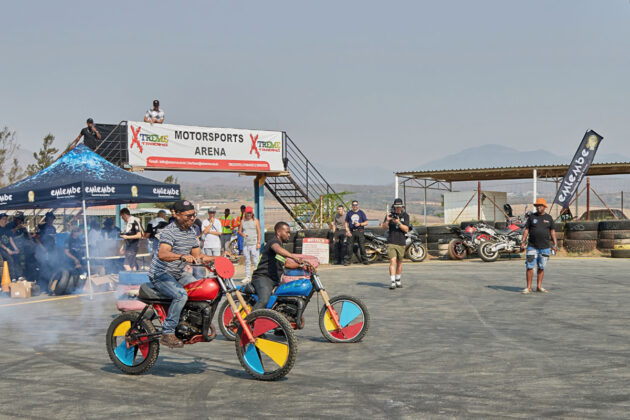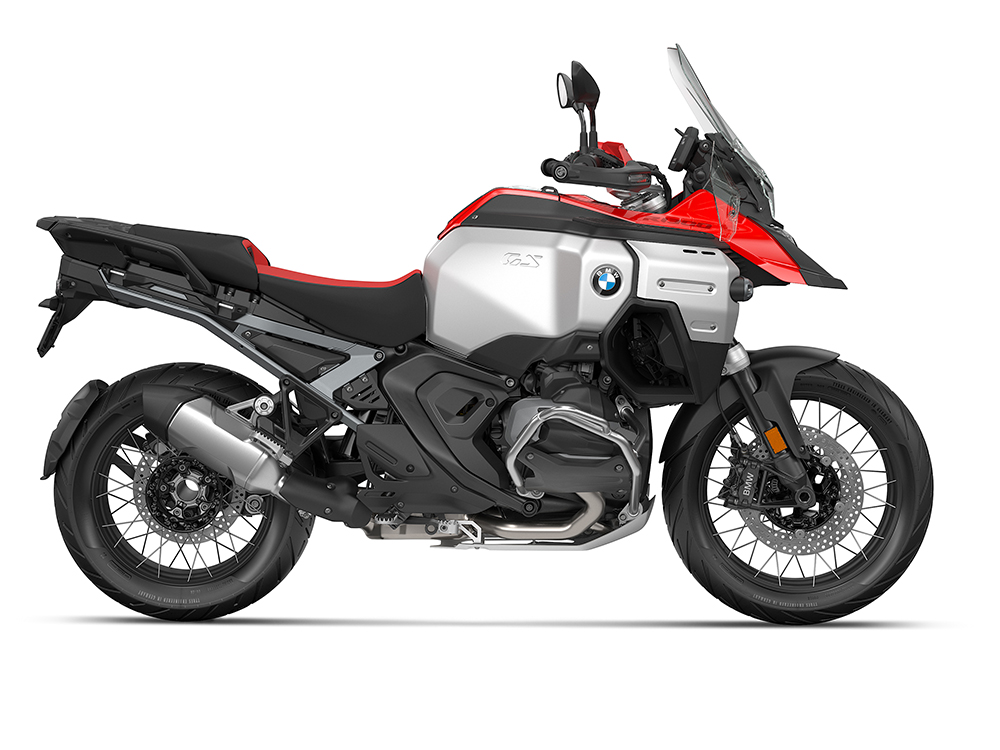Adventure: “an unusual, exciting, daring experience.” That’s the insipid definition Google dishes up. Sounds like the blurb for an Enid Blyton storybook. But Africa’s not for sissies! For dual-purpose bikers, adventure means thrashing through the fesh-fesh on a gnarly track, testing the limits of the tyres’ adhesion on a mountain pass, ducking behind the screen to hit maximum velocity on a deserted tar road, hauling along an unfamiliar dirt highway at sphincter puckering speeds, and riding ace pilot into unknown terrain.

On Wednesday, when I collected the red, white and blue, fresh out of the box, BMW R 1300 GS Adventure Trophy Edition from Motorrad in Sandton, it was my absolute intention to go adventuring, to ride roads I had never ridden before, and to absorb alien sights and sounds and smells and sensations.
Once I left Sandton and headed for Nelspruit, it didn’t take long to find the first bit of dirt. Near Etwatwa in the fallow fields on the southern side of the N12, there’s an ancient ruin far away in the veld. It’s always intrigued me, and today was the day to see it up close. My mojo was with me and the GS felt agile and responsive as we bounded along the middelmannetjie track through the veld. A few minutes later, I stopped for photos at the remnants of what might once have been a farmhouse. Back on the N12, there was a pungent odour of pork products, so I did the wise thing, set cruise control at 130km/h and relaxed in the saddle for the next 100km to Witbank.

On the outskirts of Witbank, I left the N12 and rode south on the R544 towards Vandyksdrift. It’s been a while since I took this route, and it was even more grim than I remembered. Witbank is infamous for all the wrong reasons. Witbank has the dirtiest air in the world. Greenpeace analysis of satellite data revealed that Mpumalanga is the largest Nitrogen Dioxide hotspot across six continents. The area has been plagued with deadly air quality for decades, with a high concentration of coal-fired power plants, a coal-to-liquids plant, and a refinery contributing large amounts of pollution, resulting in thousands of cases of bronchitis and asthma. The R544 is rutted and potholed because it carries a never-ending cavalcade of 26 wheel interlinks with a loaded mass of 56 tons and 34 wheel behemoths with a loaded mass of 74 tons!!! The roadside vegetation is black and stunted. The air is gritty and tastes of chemicals. At Vandyksdrift, dozens of interlinks roared in and out of the coal terminal, kicking up a filthy black cloud that hung like a malevolent wraith over the coal-scarred landscape.
From Vandyksdrift, I rode due east on the R542. Near Blinkpan, there was an irresistible scene of destruction in the veld. I left the tar and followed the railway service road to a Transnet rolling stock graveyard. Four smashed locomotives lay abandoned to the elements, and next to them were heaps of wrecked wagons, tortured metal and mangled bogies. It was a catastrophic sight, and I shuddered to think of the terrible forces that transformed proud machines into twisted scrap.

I continued east and shortly before long crossed the R35, which connects Middelburg and Bethal. I wasn’t looking forward to the next 20km to Hendrina. The last time I travelled that road, there were more potholes than tar. But much to my shock and surprise, there were roadworks taking place. Half the distance was brand new tar, and the other half was a dirt detour in decent condition. I did my best meerkat imitation and cruised the detour at 120km/h, the GS loving the dirt as much as I was. When the road works are complete, this route might just be my new favourite four-wheeled route from Gauteng to Mpumalanga and to hell with the N12/N4.

In Hendrina, I stopped at KFC for my customary padkos, Street Wise Two and a Coke. My lunch was interrupted by a tumult of sirens. A horde of cop cars came tearing up the main drag, clearing a path for the convoy of abnormal vehicles that followed. Six Scania prime movers thundered through town, each carrying a huge metal cylinder. As quickly as they arrived, they were gone, and it was time for me to hit the road again. The R38 from Hendrina to Carolina traverses a desecrated landscape. The plains are blemished by unsightly slagheaps, mine dumps and mountains of overburden. Coal country is ugly!

Carolina is the eastern extremity of the coalfields, and from there it’s a pleasure to ride the undulating roads through mountainous Mpumalanga. It’s 50km from Carolina to Badplaas, 50km of flatstick, pristine tar, a roller coaster road that swoops and rises over the foothills of the Hlumuhlumu range, ‘the place of much thunder’. I had cruise control set at 180km/h, but this was the perfect spot for a top-end run. I tucked in behind the windshield, the GS surged to warp speed, and I backed off when I saw 222 on the speedo. That’s what the BMW marketing material means when it coyly states a top speed of greater than 200km/h. On the far side of Badplaas, I stopped at the general dealer for photos and a Coke and then continued east towards Barberton.

This is a magical rider’s road that includes two challenging passes, Nelshoogte and Bothasnek, both in good condition with long sweepers, tight switchbacks, and everything in between. Where the R38 intersects the R40, I turned north to Nelspruit and, like a horse scenting the stable, bolted for home at speed. By now, I was completely confident of the Michelin Anakee Adventure tyres on the GS, and I spanked up and over Hilltop Pass, maintaining optimum revs by tapping up and down on the gear lever, more of which later. When I stopped in my driveway and inspected the rear tyre, it was no surprise to see that there wasn’t even one millimetre of chicken strip. Magnificent motorcycle. Excellent tyres.
The GS Adventure I rode was equipped with BMW’s “automated shift assistant” transmission. There’s no clutch lever, but there is a gear lever. Under your left thumb, a switch engages automatic or manual modes. Full auto mode works well on the open road and changes up and down intuitively so that power is always available.

Auto is less practical around town and in traffic. Random acceleration and deceleration sometimes confuses the shift assistant as it hunts for the correct gear. The simple solution is to use the gear lever. I soon discovered that what worked for me was to always select full auto, D on the TFT screen readout, and to use the gear lever when necessary. Having said all that, when I buy my 1300, I will opt for a clutch lever and not an automatic.
On Friday morning, I packed the GS and retraced my Wednesday route to Badplaas. My destination for the weekend was Eswatini and the 32nd Swazi Rally. In Badplaas, I took the R541 towards Elukwatini and joined the N17 at Lochiel. The weather was perfect, the N17 was almost deserted, and the bike was running like a long dog. I was captivated by that ineffable feeling of serenity and contentment that only bikers can know. When you’re riding, you are what you are right there and then. There are no yesterdays on the road. A good ride is the antidote to all the twak on social media and all the nonsense we deal with every day. Nothing clears the mind like a good day in the saddle.

I was feeling peckish, so I stopped at Flip’s Butchery on the outskirts of Amsterdam. In my experience, platteland butcheries make delicious droëwors, and Flip’s did not disappoint. Two friendly ladies, Irene and Lizelle, offered me wors and biltong to taste, and I couldn’t resist buying R200 of outrageously tasty droëwors.

Further into town, I simply had to stop for photos of the enormous rigs parked at the side of the road. A trio of Scania horses was hauling wind turbine blades. The driver of one of the rigs told me the blades were going to a new wind farm near Bethal. Each blade is 91.6m long and weighs 24 tons!

A few hundred metres further, there were two rigs hauled by Volvo FH-16 four-axle tractors. The loads were 6.9 metre diameter steel cylinders, each weighing 104 tons. Their destination was a new fertiliser factory in Harare, 1200km distant. The rigs travel approximately 50km per day, which means they still had three to four weeks on the road.

Amsterdam to Piet Retief is 50km of high-speed blacktop, which winds through never-ending plantations of pine and eucalyptus. This is the heart of timberland, and the air is perfumed with the heady aroma of newly felled trees and busy sawmills. I stopped at Kemp railway siding for photos.

Every year, thousands of tons of timber pass through the siding en route to consumers countrywide. I stopped for fuel in Mkhondo, a town which exhibits a striking resemblance to Piet Retief. While the petrol jockey was filling the tank, I walked across the road to take a photo of the beautiful NG Kerk, designed by Gerhard Moerdyk, the architect of the Voortrekker Monument. I was amazed, but not amused, to find the church precinct secured by an electric fence, a sign of the times in this beloved country.

Eswatini is a small country with a total boundary length of 535km. The South African boundary is 430km. The Mozambican boundary is 105km. Despite the short perimeter, Eswatini has thirteen border posts; eleven with South Africa and two with Mozambique. In the fullness of time, I plan to ride through every one of those border posts. Today, I would tick Bothashoop off the list. I rode east from Piet Retief, and after a few clicks, the tar ended and a dirt highway between plantations stretched ahead. I settled into my 140km/h dirt comfort zone and soon arrived at the border post.

I was the only traveller and in less than five minutes I was loose on the land in the Kingdom of Eswatini. The new tar road through Gege and Nhlangano is immaculate and beckons faster, faster, but you need a death wish to speed in Eswatini. The roads and roadsides are infested with goats, cattle and donkeys. Eswatini livestock has been the ruin of many a poor boy. Rather take it easy and enjoy the scenery. In Nhlangano, I headed north towards the Grand Valley of the Mkhondvo River. It was a lovely ride. The temperate spring sunlight fell through the roadside acacias, and between their trunks I saw green glimpses of riparian foliage and the distant radiance of the river. I stopped on a low-level bridge across the river to enjoy the rustic scene.

A hundred metres upstream, young lads were cavorting in the shallows, cattle grazed the lush banks, and waterfowl bobbed on the current. I didn’t linger long. I was thirsty and borne on the breeze I heard the Sibebe Lager siren song, “Howie, come and drink me.” Fifteen minutes later, I pulled into Riders’ Ranch, home of the Swazi Rally.

This was the 32nd Swazi Rally hosted by Carlos and Sonia Paiva. Since its humble beginnings, the rally has grown in stature and popularity. Riders come from across southern Africa for a weekend of nonstop partying, pumping music, motorised mayhem, drag racing, good food, inexpensive booze, male and female strippers, insangu aka Swazi Gold, and friendly ladies who get even friendlier if you buy them a drink!

Carlos and Sonia have been to the Isle of Man TT Races many times and speak with admiration of the castellated Manx castles featuring towers and battlements. Some years ago, Carlos decided to build his own Afrocastle, and this massive structure is now the focal point of the rally. The Afrocastle is home to bars, restaurants, the main stage and dancefloor, and Carlos’s priceless collection of classic motorcycles. I parked the GS and went in search of beer. Freshly poured 500ml Sibebe Draught Lager costs E30.

The first one disappeared swiftly, and I strolled the site, sipping the second glass of golden throat-charming nectar. It was organised chaos across the site as the party people streamed in, set up their tents, lit their fires, pumped up the volume on their sound systems and got down to the serious business of chucking booze down their gullets. I finished my beer and rode down to the Paiva homestead for my habitual afternoon siesta. There was a long night ahead.

At sunset, I strolled back to the rally site and hooked up with the Nelspruit conneckos. We spent a chilled evening listening to the brilliant DJs, sipping our beers and talking twak. Intermittently, the merriment was punctuated by the merciless revving of superbikes, just normal rally behaviour. One bloke took it to another level. He trailered his Suzuki Boulevard to the rally, left it on the trailer and spent the weekend torturing the poor beast for minutes at a time, which I thought demonstrated a retarded lack of mechanical empathy. After midnight, things hotted up in the hall as the strippers took the stage.

It was getting a bit too steamy for me, and it was long past my bedtime, so I headed back to the homestead. The sounds of revelry grew faint as I walked through the mango groves under the starlit sky bowl. The sounds of nightbirds and insects faded as I approached and started again when I passed. The cattle in the kraal lowed mournfully, and in the distance a dog barked an alarm. I was in a very happy place. I’m 70 years old, and if I weren’t a biker and a rally goer, I wouldn’t experience these simple pleasures. This day had been the essence of ‘la dolce vita’.

The Riders’ Ranch Motorsport Arena is a short walk from the Afrocastle. When I arrived at the arena at 10:30 on Saturday morning, the grandstands were filling up and the boys from Jungle Rush FMX were performing their gravity-defying stunts. For the next six hours, it was nonstop action, including maniacs in hot saloons spinning and drifting, skilful lads performing wheelies and stoppies, slow races, egg and spoon races, and the highly anticipated drag races. Swazi Rally men take the drags very seriously. Ultimately, it was a shootout between Alex from Maputo on an S 1000 RR and Jordan, the winner, on a Kawasaki H2.
By 18:00, the main hall was a seething mosh pit of humanity. King Don, an astonishing guitarist, and his drummer rocked the joint.

The lucky draw prize, a brand new Suzuki GSX-S1000GX, was lifted onto the stage. The crowd was at fever pitch when the draw took place at 20:00. The winner was Tsholofelo Phoku from Middelburg. The Swazi is the only rally that still has a new superbike as a prize. Prize giving over, it was party time yet again. The festivities raged until sunrise on Sunday morning. So I’m told. I wasn’t there. I was sleeping the sleep of a rallied-out man.

When I crossed the border on Friday, the friendly Eswatini border people gave me a detailed map of the country, which prompted me to plan a new route home. I said my fond farewells and was on the road by 10:00, riding north to Manzini, Mafutseni and Luve. In Luve, I left the tar and rode easy dirt deep into the highlands of northwest Eswatini. The vistas were spectacular, range after range of mountains fading to grey where the land met the sky. Twice, I came to intersections where I wasn’t sure which fork to follow and where friendly local folk pointed me in the right direction. The dirt road ended near Maguga Dam, where I stopped on the dam wall for photos before continuing to Piggs Peak.
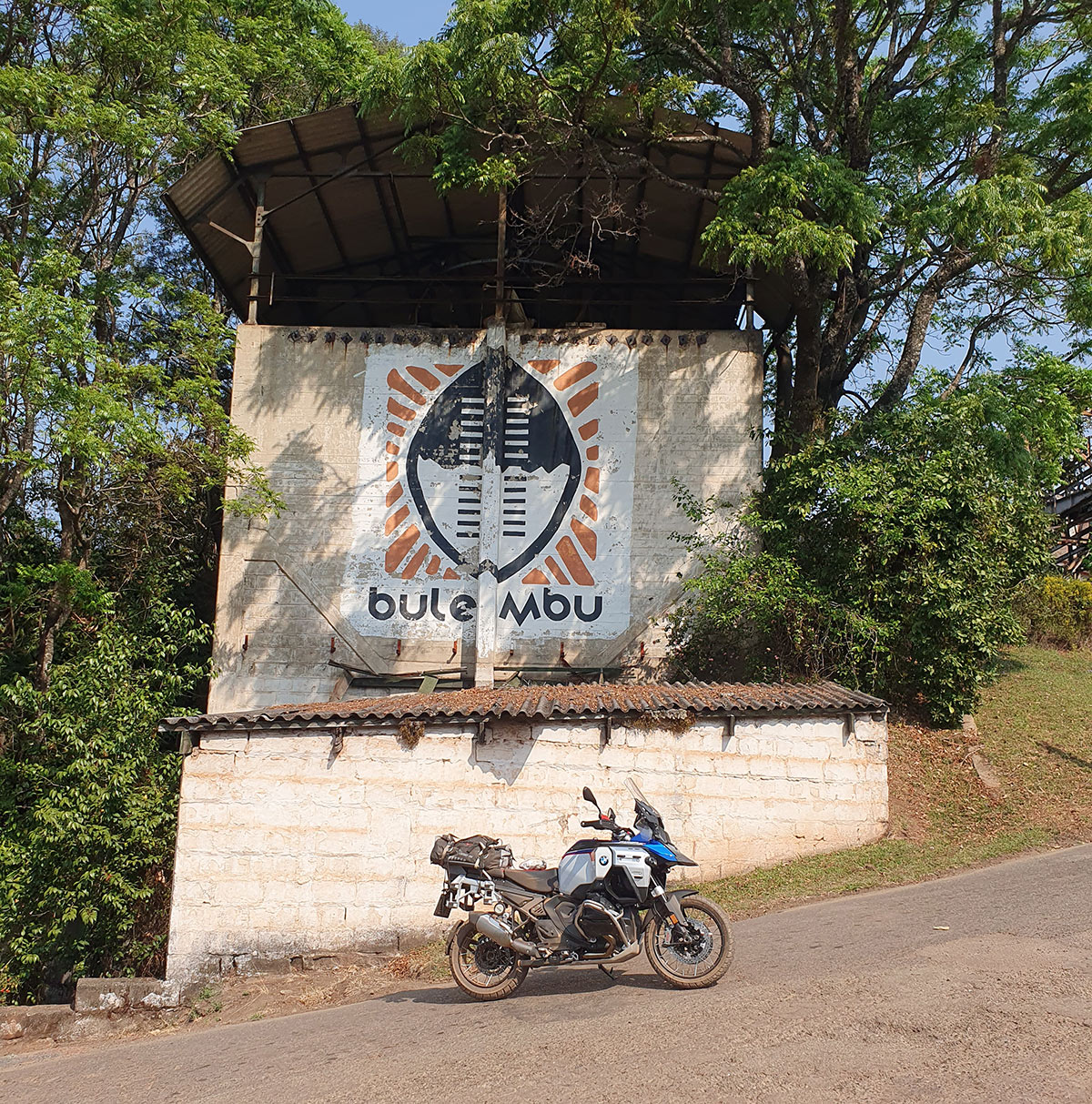
Many times I’ve ridden the 25km dirt road from Piggs Peak to the Bulembu border post. That road has always been challenging, but on this day it was bloody awful, rough as a bear’s arse. Just a kilometre into the dirt, I hit the first stretch of fesh-fesh. The dirt exploded beneath the wheels of the bike, and because there was a tailwind, I found myself in an impenetrable brown cloud. Fesh-fesh flows like quicksand and covers rocks and potholes, and it was a miracle I didn’t bin the GS as it hammered over these invisible obstacles. That patch of treachery ended, but it wasn’t the last. The road is used by monster logging trucks that pulverise the sand particles into talcum. It was lonely out there in the mountains, and I rode well within my limits. I had no desire to crash and find myself lying under the GS, hoping that a good Samaritan would find me. It was a relief to reach the border unscathed and to ride the scenic Geotrail www.geotrail.co.za, which winds for 40km from Josefsdal to Barberton over the rugged Makhonjwa mountains. From Barberton, it was a quick dash home through the valley of the Kaap River and over Hilltop Pass. And that’s the versatility of the GS. Riding gnarly dirt, spanking challenging tar and everything in between. It’s the motorcycle for every eventuality.

On the ride back to Joburg the next day, I had the opportunity to reflect on my time in the saddle of the GS. This latest incarnation of the legendary GS is more capable, more refined and way faster than its ancestors. It looks imposing, tall, wide-shouldered, and carries a man-sized 30-litre fuel tank. Thanks to slimmer ergonomics at the waist, it feels more manageable than its size and 269kg wet weight suggest. The 1300cc ShiftCam boxer twin produces 107kW of power and 149Nm of torque. Cruising all day at 180km/h is effortless with the mill ticking over at 6000rpm. One of the smartest changes from the 1250 is the redesigned cooling system. The 1300 has twin side-mounted radiators with carefully directed hot air outlets. On the 1250 riders often complained of cooked legs as radiator heat was blown straight onto the thighs. BMW has solved this by channelling hot air away from the rider’s legs, making the bike noticeably cooler and more comfortable on long rides. The radiators are more efficient than those on the 1250, and the engine runs at lower temperatures. On the long road, the 1250 typically runs at around 84°C while the 1300 runs consistently at 77°C. Long-travel suspension, 210mm front and 220mm rear, inspires confidence on and off road. Over 1500km on the average fuel consumption was 17km/L, giving a realistic range of 500km. The 1300 is kitted with a plethora of electronics; ABS, TFT cockpit, LED lights, four ride modes, electronic suspension settings, cruise control with radar sensors, heated grips, electrically operated windscreen and keyless ignition.

This is the mothership, the ne plus ultra, the buck’s balls, the crème de la crème, the GOAT, the motorcycle that underpins Motorrad’s success and which sells by the container load every year. You know you need one. So do I. Depending on how you configure your BMW R 1300 GS Adventure, the price will be in the region of R400,000.
BMW R 1300 GS Adventure
For more information on the bike that we tested in this article, click on the link below…





